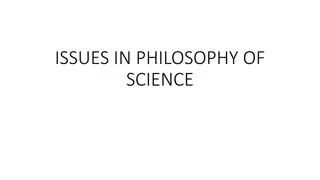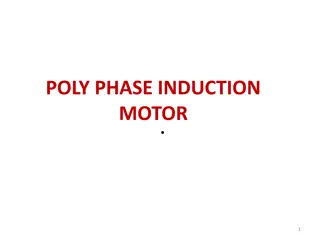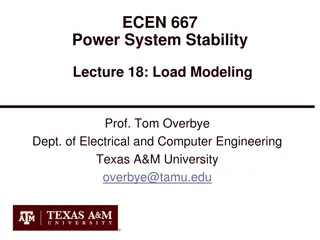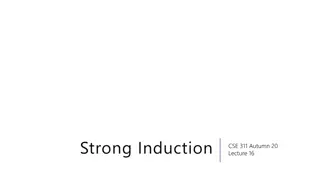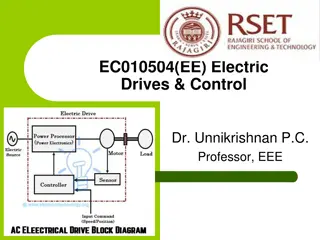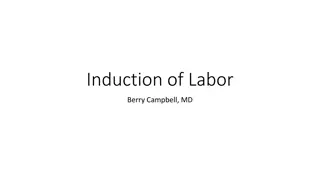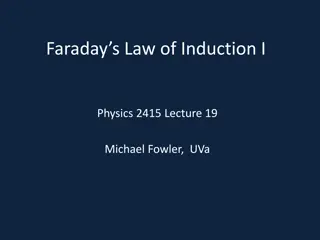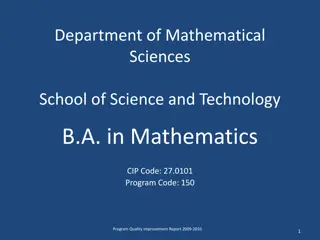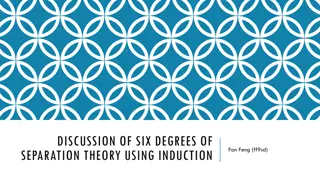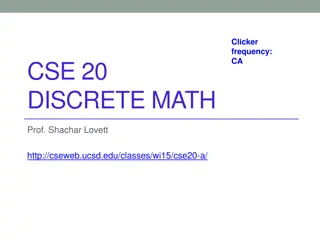Mastering Mathematical Induction
The power of mathematical induction with proofs, odd powers, divisibility by prime numbers, and the induction rule. Understand how to prove statements using induction techniques.
Download Presentation

Please find below an Image/Link to download the presentation.
The content on the website is provided AS IS for your information and personal use only. It may not be sold, licensed, or shared on other websites without obtaining consent from the author.If you encounter any issues during the download, it is possible that the publisher has removed the file from their server.
You are allowed to download the files provided on this website for personal or commercial use, subject to the condition that they are used lawfully. All files are the property of their respective owners.
The content on the website is provided AS IS for your information and personal use only. It may not be sold, licensed, or shared on other websites without obtaining consent from the author.
E N D
Presentation Transcript
Induction (chapter 4.2-4.4 of the book and chapter 3.3-3.6 of the notes)
This Lecture Last time we have discussed different proof techniques. This time we will focus on probably the most important one mathematical induction. This lecture s plan is to go through the following: The idea of mathematical induction Basic induction proofs (e.g. equality, inequality, property,etc) An interesting example A paradox
Odd Powers Are Odd Fact: If m is odd and n is odd, then nm is odd. Proposition: for an odd number m, mk is odd for all non-negative integer k. Let P(i) be the proposition that miis odd. Idea of induction. P(1) is true by definition. P(2) is true by P(1) and the fact. P(3) is true by P(2) and the fact. P(i+1) is true by P(i) and the fact. So P(i) is true for all i.
Divisibility by a Prime Theorem. Any integer n > 1 is divisible by a prime number. Let n be an integer. If n is a prime number, then we are done. Otherwise, n = ab, both are smaller than n. If a or b is a prime number, then we are done. Otherwise, a = cd, both are smaller than a. If c or d is a prime number, then we are done. Otherwise, repeat this argument, since the numbers are getting smaller and smaller, this will eventually stop and we have found a prime factor of n. Idea of induction.
Idea of Induction Objective: Prove This is to prove The idea of induction is to first prove P(0) unconditionally, then use P(0) to prove P(1) then use P(1) to prove P(2) and repeat this to infinity
The Induction Rule 0 and (from n to n +1), Much easier to prove with P(n) as an assumption. proves 0, 1, 2, 3, . Very easy to prove P (0), P (n) P (n+1) m N. P (m) For any n>=0 Like domino effect
This Lecture The idea of mathematical induction Basic induction proofs (e.g. equality, inequality, property,etc) An interesting example A paradox
Proof by Induction Let s prove: r 1. Statements in green form a template for inductive proofs. Proof: (by induction on n) The induction hypothesis, P(n), is: r 1.
Proof by Induction Induction Step: Assume P(n) for some n 0 and prove P(n + 1): ) 1 + n +1 ( 1 r + + + + = n +1 2 1. 1 r r r r 1 r Have P (n) by assumption: So let r be any number 1, then from P (n) we have + n 1 1 r + + + + = n 2 1 r r r 1 r How do we proceed?
Proof by Induction adding r n+1to both sides, + 1 n 1 r + + + + = + n +1 1 n n 1 r r r 1 r 1 + + + 1 n n 1 ( 1) r r r = 1 r ) 1 + n +1 ( 1 r = 1 r But since r 1 was arbitrary, we conclude (by UG), that ) 1 + n +1 ( 1 r + + + + = n +1 2 1. 1 r r r r 1 r which is P (n+1). This completes the induction proof.
Proving an Equality Let P(n) be the induction hypothesis that the statement is true for n. Base case: P(1) is true Induction step: assume P(n) is true, prove P(n+1) is true. by induction
Proving a Property Base Case (n = 1): Induction Step: Assume P(i) for some i 1 and prove P(i + 1): Assume Is divisible by 3. is divisible by 3, prove Divisible by 3 Divisible by 3 by induction
Proving a Property Base Case (n = 2): Induction Step: Assume P(i) for some i 2 and prove P(i + 1): is divisible by 6 Assume Prove is divisible by 6. Divisible by 6 by induction Divisible by 2 by case analysis
Proving an Inequality Base Case (n = 3): Induction Step: Assume P(i) for some i 3 and prove P(i + 1): Assume , prove by induction since i >= 3
Proving an Inequality Base Case (n = 2): is true Induction Step: Assume P(i) for some i 2 and prove P(i + 1): by induction
This Lecture The idea of mathematical induction Basic induction proofs (e.g. equality, inequality, property,etc) An interesting example A paradox
Puzzle Goal: tile the squares, except one in the middle for Bill. n 2 n 2
Puzzle There are only L-shaped tiles covering three squares: For example, for 8 x 8 puzzle might tile for Bill this way:
Puzzle Theorem: For any 2nx 2n puzzle, there is a tiling with Bill in the middle. Did you remember that we proved is divisble by 3? Proof: (by induction on n) P(n) ::= can tile 2nx 2nwith Bill in middle. Base case: (n=0) (no tiles needed)
Puzzle Induction step: assume can tile 2n x 2n, prove can handle 2n+1x 2n+1. n 2 Now what?? + 1 n 2
Puzzle A stronger property The new idea: Prove that we can always find a tiling with Bill anywhere. Theorem B: For any 2nx 2n puzzle, there is a tiling with Bill anywhere. Clearly Theorem B implies Theorem. Theorem: For any 2nx 2n puzzle, there is a tiling with Bill in the middle.
Puzzle Theorem B: For any 2nx 2n puzzle, there is a tiling with Bill anywhere. Proof: (by induction on n) P(n) ::= can tile 2nx 2nwith Bill anywhere. Base case: (n=0) (no tiles needed)
Puzzle Induction step: Assume we can get Bill anywhere in 2nx 2n. Prove we can get Bill anywhere in 2n+1x 2n+1.
Puzzle Induction step: Assume we can get Bill anywhere in 2nx 2n. Prove we can get Bill anywhere in 2n+1x 2n+1. n 2 n 2
Puzzle Method: Now group the squares together, and fill the center with a tile. Done!
Some Remarks Note 1: It may help to choose a stronger hypothesis than the desired result (e.g. Bill in anywhere ). Note 2: The induction proof of Bill in corner implicitly defines a recursive procedure for finding corner tilings. Note 3: Induction and recursion are very similar in spirit, always tries to reduce the problem into a smaller problem.








